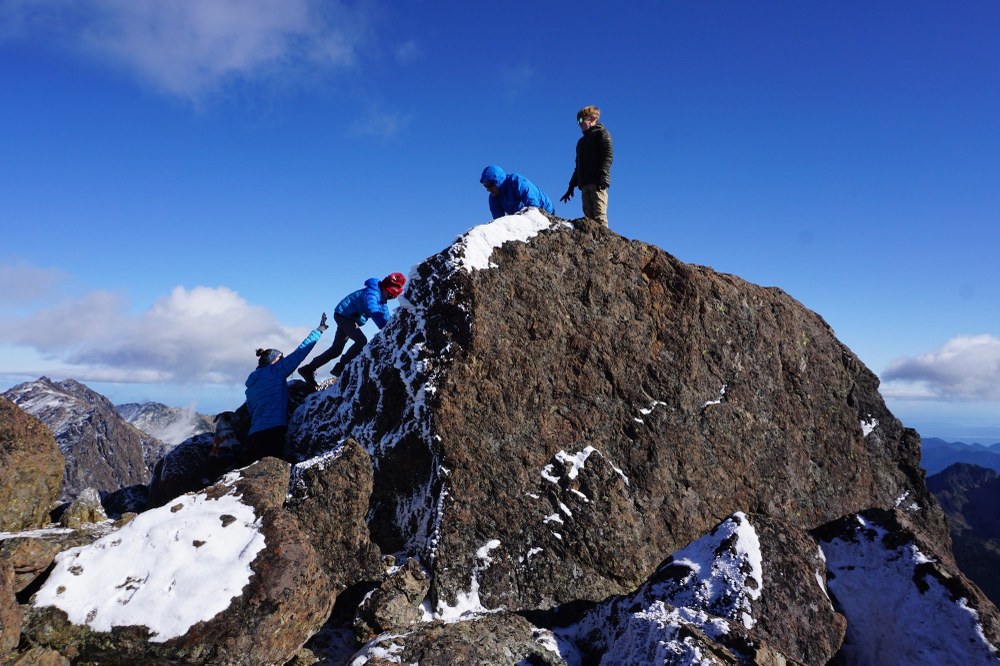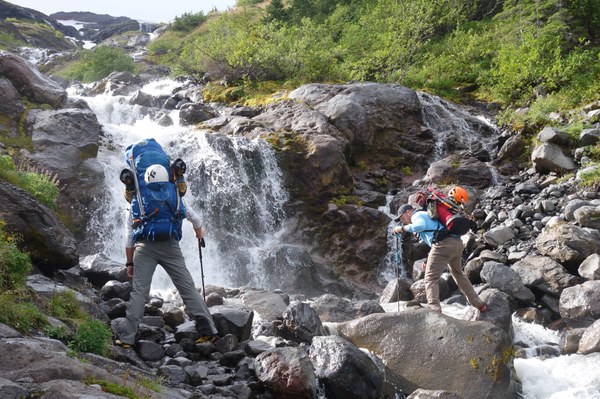
One of my first jaunts into the alpine was blindly following friends to the summit of Kaleetan Peak. As we climbed, rocks whizzed passed me, kicked off by my friends above. On the descent, my roommate slipped on a slick patch and was nearly swept down a steep chute that dropped a hundred feet below.
He was saved by the quick action of another companion, grabbing him by his collar. I count experiences like these as part of our nine lives, and by now I have burned through more than half of my own.
Today, as one of the club’s safety officers, I read incident reports and I harken back to days like those and the lessons I have learned along the way. Frequently, these are minor incidents and are largely inconsequential. However, there are often incidents and near misses that could have been catastrophic in result, often with lessons for how we might do things differently in the future. In the incident report form, we ask the reporting parties to reflect on what occurred and why. Often, the comments are something along the lines of, “There’s nothing we could have done about it. It was bad luck.” Well, was it?
At The Mountaineers, we have not yet built the type of safety culture that treats close calls like these as actionable lessons to learn from. Every incident is an opportunity to reflect, a chance to think through what, if anything, we might have done differently. In the ski and avalanche culture, we call these free lessons. I’m challenging us to adopt that mindset.
As an example, take the climbing classes we run in Leavenworth. Is it bad luck when one of our students slips on a thick mat of dry pine needles and tumbles down a rock slab, or might there have been things we could have done to prevent what occurred or mitigate their consequences? Seasoned climbers know instinctively that dry pine needles on hard slabby surfaces slide. We intuitively tip toe through, choosing islands of exposed rock to step upon. We avoid stepping squarely on thick mats of needles on slabby slopes.
One action we could take is sharing simple awareness with the groups we are managing - something along the lines of, “Hey, these pine needles are slick. Be careful as you head down this gulley.” That should be enough to get the attention of our group and put them on guard. We can model the desired behavior. “Watch how I’m stepping only on the exposed rock, not the pine needles, and I will use handholds so I can maintain three points of contact as I descend this step.” As an instructor, I am applying kinesthetics to show what to do in an experiential manner that others can observe and apply. Lastly, I can position myself below a crux or location of concern to spot the participants. That way, if they fell, I would be positioned to direct their mass and mitigate the fall. Instead of a twisted ankle or broken arm, spotting can reduce this to just a scrape and a bruised ego.
 Trip leaders Stephanie Schiller and Ronnie Parker on the approach to the Coleman Glacier. Photo by Emma Agosta.
Trip leaders Stephanie Schiller and Ronnie Parker on the approach to the Coleman Glacier. Photo by Emma Agosta.
These three things - sharing awareness, modeling behavior, and taking steps to mitigate accidents - go with our awareness of the hazard in the first place. As leaders, our job is to manage the party, and we need to be watchful of hazards and opportunities to manage the group. As these emerge, we vocalize our concerns with the team. We can then take additional steps of showing those new to the craft what to do and how. If needed, we can position ourselves to spot or to take other measures to manage the risk.
The same principles would apply to snow. As a leader, I know instinctively that hazard spikes as the snow hardens and/or as the slope angle increases. As this scenario materializes, I’ll share my concerns with my team. If it’s hard snow, I may stop and suggest we put on micro spikes. If it’s steep snow, we may need our ice axes. If I have novices in the party, I will demonstrate what I mean by a firm self-belay with an ice axe. If there are high consequences, I may pull out a rope. In each situation, I am applying additional layers of protection to build a safety margin.
Rockfall is another scenario. All too often, rockfall is party-induced where someone above is not paying attention and kicks loose rocks. It only takes a rock the size of a marble to knock you off balance, and anything bigger than a golf ball can kill you. To highlight how big a role awareness plays, I often play a game with my climbing students when we encounter talus. In this game, you score one point if the boulder you step upon rocks and others can hear it. You score three points if the talus you step on rolls or releases other rocks. Like golf, we are aiming for a low score. My students always score points initially. However, after some period, I will reset the game. Then, without fail, the students’ scores drop dramatically, sometimes to zero. Why? Because students are incentivized through competition to pay attention to where they are stepping and how. Awareness is the key, and this game helps me to model and teach novices how to climb through talus without sending down a shower of rocks.
We can apply active terrain management in a variety of settings. How often have you been the more seasoned and skilled member in a group? Have you stepped up to point things out to the new and uninitiated? As a leader or an instructor, we are the senior parties in the group. We will be more aware of the hazards out there, and it is incumbent upon us to share those concerns and advice on how to manage them. This is how we actively manage the terrain we enter, and it all originates from the actionable lessons we reflect upon.
Tony Tsuboi is a long-time member of The Mountaineers. He is a Climb Leader, AIARE Instructor, and past chair of The Mountaineers Safety Committee.
This article originally appeared in our Spring 2021 issue of Mountaineer Magazine. To view the original article in magazine form and read more stories from our publication, visit our magazine archive.
LEAD IMAGE OF Jill and Wesley Thornton with sons Werner and Townes on the summit of Buckhorn Mountain in the Olympics. Photo courtesy of Wesley Thornton.
Add a comment
Log in to add comments.Well done Tony.
When preparing to lead a trip, I try to jot down where I would expect to encounter the areas of highest risk. Then while leading the trip I try to make a conscious assessment of each upon reaching it, and ask if it is higher / lower / equal risk to what I assumed when planning. I might mention it to the participants or might not, but I keep a mental tally of the risk factors we are facing, and whether it's acceptable.
On a recent scrambling trip I led of Mt Margaret, I made a note during planning that we would have potential hypothermic conditions, and communicated that to the participants. As we ascended I was tallying multiple risk factors for hypothermia. It had rained the night before and our route involved thick bushwhacking, which got us pretty wet. Then we encountered falling temperatures, higher winds, fairly heavy snow, thick fog, and very hard snow, adding to a higher risk than I had assumed.
I was about ready to turn the group around, but then I realized my participants were stronger than my initial assumption. Additionally I realized I could change the destination from the main summit to the smaller & closer south summit, and with those considerations it put the scenario back into the "acceptable" category in my mind, and we continued.
We did fine. But if I had not taken the risk areas into account when planning, and then made a conscious assessment of actual risk vs. assumed risk during the trip, we could have easily blundered into too much exposure to the cold & wet, and possibly have had a case of hypothermia right at the worst spot - when we needed to thrust the ice axes hard into the hard snow to get secure self-belays - and something like that could easily have resulted in a fall. The conscious risk assessment was key in safety.
 Tony Tsuboi
Tony Tsuboi